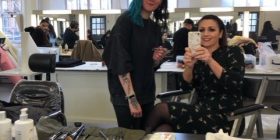Using the Better Lives Themes to Better My Practice – Blog Post 2 – John Bloom
After a wonderful series of informative lectures given by knowledgeable industry practitioners, I am greatly impacted by their words and the Better lives themes. These three pillars in which the London College of Fashion revolves around – social responsibility, diversity, and sustainability – all hold equal importance to the university and should greatly influence students continuing their degree. No matter what it is that I do now, I will always consider these themes with a high level of importance, understanding that these factors are what will reshape the industry.
The Better Lives themes of social responsibility and diversity will play large roles in the way I work going forward. These will mostly affect my research process and realization. I understand that I have an artistic voice, and with this voice it should be used responsibly. During my studies, I will always consider an a multitude audiences when choosing a research topic and producing an outcome.
We are currently in a state of climate emergency. We have entered the Age of the Anthropocene – a new geologic epoch dominated by humanity, which has been brought upon by our altering of Earth’s natural cycles due to the last 250 years of rapid industrialization. It is quite unnerving to sit with this heavy information and continue my studies where I will join an industry that has been a major contributor in entering this new epoch. However, I believe that being aware of these ramifications is where change can begin. In fact, it has already begun. For the past year, I have been challenging myself to create the least amount of waste as possible. After Kate Fletcher’s remarkable lecture on nature, my desire to produce less waste grew stronger. It has empowered me to focus both my long and short term goals on sustainability, one day hoping to land a job connected with this matter. As I will continue to consider sustainable viewpoints for any project I take on in the future, it remains a challenge to think outside the box and express creativity. It is no longer a time where editorial shoots can be shot in luxury locations or acquire massive budgets for set design and curation. It truly is wonderful that creatives can express themselves in this way, but it would be even more interesting to see them use activism to raise awareness. It is time for creatives to focus the spotlight on sustainability and express themselves in ways larger than ever before. No longer do we have the luxury of creating ego stories. We now have no other choice but to see the bigger image and remove ourselves from the center of the universe. This responsibility also rests on the shoulders of incoming creatives. Fashion and art enables us to shape our ethical landscape. It can create narratives, either personal or share, and the imagery can have a powerful affect on the audience if done right.
Furthermore, one thing I would like to explore is the concept of the block chain. Nick Almond discusses this idea, explaining how it can provide transparency. This could perhaps be useful for authenticity checking in order to better understand where our clothes are coming from and what exactly it is made from. By seeing how are our clothes are made, it provides a tangible experience that the consumer feels apart of. The consumer is made aware that their garment was produced ethically. Almond refers to this as a “trust architecture”.
References
Almond, N 2020, Emerging Technologies in Fashion, lecture notes, Better Lives Unit FU001708, London College of Fashion, delivered 14 February 2020.
Fletcher, K 2020, Nature, lecture notes, Better Lives Unit FU001708, London College of Fashion, delivered 13 February 2020.
Welcome to the Anthropocene (2012) Welcome to the Anthropocene. 2012. Available at: http://www.anthropocene.info/short-films.php (Accessed: 04 April 2020).


Ruby Donohoe: Blog Post 4: Peer Review of Daisy Easterby-Sands Blog Post 2 Among other’s Better Lives blogs, I read Daisy Easterby-Sands…